 Facebook
Facebook
 X
X
 Instagram
Instagram
 TikTok
TikTok
 Youtube
Youtube
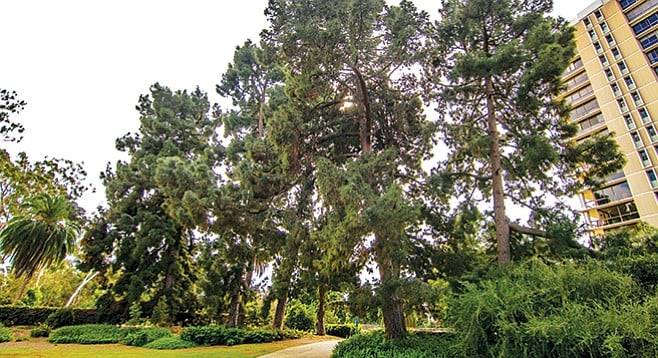
At 8 a.m. on a cool Wednesday morning in fall, park gardeners keep to the edges of the main thruways so the early-morning joggers can maintain their speed through the park’s heart from Sixth Avenue to Park Boulevard. But while gardeners garden and joggers jog, a smattering of tourists wander in and out of the covered walkways around the Plaza de Panama gripping the straps of their backpacks while they wait for the museums to open. They must not know that Balboa Park’s museums open at 10 on weekdays.
For the sake of these waiting wanderers, and for the residents and return visitors looking for another park experience, I enlisted the help of some knowledgeable local folks to create a list of the top ten trees in Balboa Park, which are accessible at any hour. (Although, be advised that there’s a reason city park rangers wear bulletproof vests and carry guns.)

One thing to know before reading on is that of the 400-plus species growing in the park, there are far more than ten spectacular, interesting, important, or historical trees, including 25 or 30 types that historically have been known to live 1000 years.
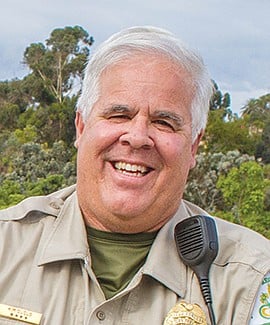
“At a certain point, when the buildings have crumbled and all the people are gone, some of these plants could be only halfway through their lives,” says Kim Duclo, a longtime city park ranger.

Besides old trees, the park is home to some rare trees, some bizarre trees, and some beautifully ordinary trees, so the number of possible top-ten lists is infinite.
Canary Island pines, Marston House
Our tour begins as you enter the grounds of the Marston House Museum at Seventh and Upas, near Balboa Park’s far northwest corner. Immediately after you cross into the grounds, take ten steps and crank your neck back to look all the way up to the tops of the eight Canary Island pines (Pinus canariensis) that grow on either side of the walkway.
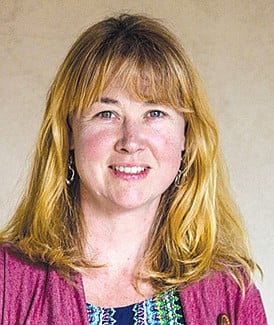
If the wind is blowing and the sun is shining, the dark green pine needles at the top will catch the light and sparkle. These evergreen trees are native to the Canary Islands of Spain and have a fissured red-brown bark that looks almost like puzzle pieces. They are huge and awe-inspiring. According to Kim, these eight evergreens were planted somewhere around March/April of 1906, and the tallest of them is approaching 120 feet. On a sunny Tuesday afternoon in September, I catch a man named Ted Bruno walking past this small grove with a piece of pizza in each hand, and I ask him to pick a favorite of the eight to be included in the list. He looks up, looks around, and chews his pizza, contemplating the question. Finally he says, “If they’re part of the same group, I think we should favor them all.” And so we shall. This group, then, is the first tree on our list.
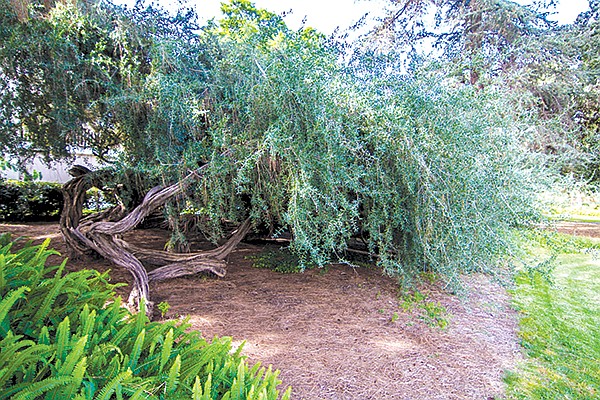
Gandalf Australian tea tree. Marston House
From the Canary Island pines, stay on the paved walkway, take a few steps toward the house, and look for the low-growing, gnarly tree on the left. This Australian tea tree warrants a history lesson from Kim, who tells stories of scurvy (caused by vitamin C deficiency) for the Europeans on Captain Cook’s voyages of discovery in the South Pacific. Somewhere along the way, they learned that if you boiled the leaves of the Australian tea tree, you could make a tea with a high vitamin C content to ward off the disease. Considered a shrub or multi-trunk tree, the Leptospermum laevigatum has what’s called a prostrate growth habit whereby the twisty trunks grow nearly horizontal along the ground and occasionally set down roots where the limb sits. The low, wide canopy of this particular tree (which Kim says was likely planted by Balboa Park’s godmother Kate Sessions around 1906) provides a nook to escape the world for a while.
“What I love about this is its crazy, twisty, gnarled look,” Kim says on a cloudy afternoon in late August. “I don’t know whether it looks like it’s from Harry Potter or Lord of the Rings.”
A month later, I meet a man named Robert Gill who happens to be wandering the Marston House grounds drinking a bottle of water and “looking for inspiration.” When I ask him to give the tree a name based on either Harry or Lord, he chooses “Gandalf.”
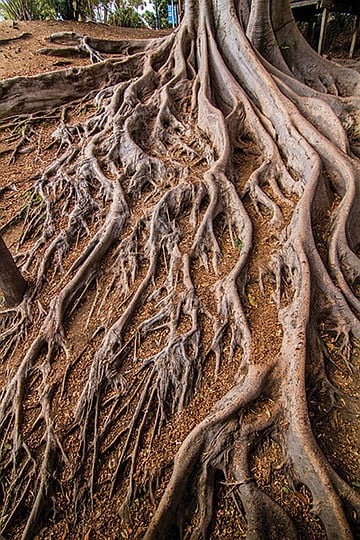
Moreton Bay fig, Palm Canyon
From the Marston House grounds, head south on the paved path that runs parallel to Balboa Drive (itself parallel to Sixth Avenue) and make your way toward El Prado (Laurel Street). Along the way, you’ll spot a couple of homeless encampments, a construction worker or two resting in the shade on a lunch break, and maybe a speed-walker. After you pass Redwood Circle (where many of the eponymous trees are dying), the Trees for Health Garden, and the Lawn Bowling lawn, turn left onto Cabrillo Bridge. Cross the bridge, pass the Museum of Man, and when you get to Alcazar Garden turn right and head for the parking lot on the other side of the maze of low hedges. Feel free to stop and chat with one of the plein air painters that often work in this spot.
Cross the parking lot and head for the wooden bridge that crosses Palm Canyon. You’ll be walking toward the Organ Pavilion whose whiteness you can glimpse through the foliage ahead. Once you’re on the wooden platform, you’ll see three giant tree trunks directly on your right. Continue walking toward the steps that lead down into Palm Canyon and when you reach them, turn around to look at the Moreton Bay fig tree (Ficus macrophylla) whose massive root structure extends down into the canyon. I have named her Abbey because her height and elegance, and her flying buttress roots, call to mind Westminster Abbey, Notre Dame, and other famous Gothic cathedrals.
I find Eric Ortiz and Michele Stone on the part of the platform that overlooks Abbey’s enormous buttress roots that reach down into the canyon where they take firm hold of the earth. Ortiz and Stone are visiting San Diego from Phoenix for two days. They spent yesterday at a beach in La Jolla and have made it a point to visit the trees of Balboa Park before they head back to Arizona tomorrow. Ortiz has seen Abbey before. Stone has not. When I ask her what she thinks, she makes an explosion sound with her lips as if to say, “Mind blown.” She says, “I don’t know if you can quote that, but…” then makes the sound again.
“We’re going to Facebook like crazy,” Ortiz says, snapping another photo.
Instagrammers, Facebookers, and wedding photographers often climb down into the canyon and up into Abbey’s roots, using them as a dramatic background for photos. The off-the-beaten-path location of this particular tree (which was planted in the 1930s or ’40s) has so far made extra security measures unnecessary. (See tree #7).
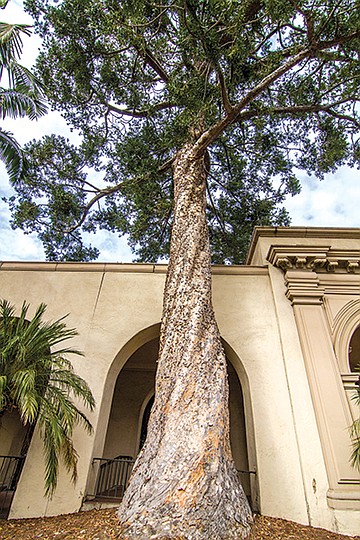
Kauri pine, Mingei Museum
Continue across the bridge over Palm Canyon and take a sharp left at the end. Cross the two narrow parking-lot inlet/outlets and then head up the short grassy slope just before you get to the covered walkway outside the Mingei. Look for the tall tree with the mottled peachy-gray trunk covered in peeling bark. Take a moment to get your bearings and soak it in because this tree, the (Agathis australis) may be the most valuable thing in the park. Commonly known as the kauri pine (or just kauri), this slow-growing tree is native to New Zealand and was likely planted here in the late 1930s or early 1940s. The peeling bark prohibits parasitic plants from taking hold.
Kauri trees are among the largest (total mass) in the world and can live upwards of 2500 years. The largest known living kauri tree grows in Waipoua, New Zealand. It’s 150 feet tall and has a trunk girth of 50 feet. Kim estimates the Agathis australis in Balboa Park at about 65 feet tall.
Jacqueline Higgins, director of planning, design, and programs at the Balboa Park Conservancy, was the first to introduce me to this tree. The reverence she has for it makes me feel ashamed of the hundreds of times I’ve walked past it without a single glance.
“When we look at trees, we look at them for their aesthetic beauty but we also look at them for the carbon sequestration,” Higgins says. “A tree this size and this age has a tremendous value for carbon sequestration.”
To prove her point, she directs my attention into the covered walkway next to the tree, pointing out the two stairs up and two stairs down that were built so that the sidewalk would go over the roots and protect the tree.
Kim emphasizes Agnes’s importance, too: “[Horticulturist Kathy Puplava] used to tell me that if we were to get rid of every single plant in this park from worst to best, the last thing that would be left would be this tree. And she even went so far as to say, ‘I don’t just mean plants; I mean paintings and works of art, cars.’ To her, that was the most valuable thing in the park.”
In honor of the tree’s Latin name, Higgins decides that Agnes is a good name for this beauty.
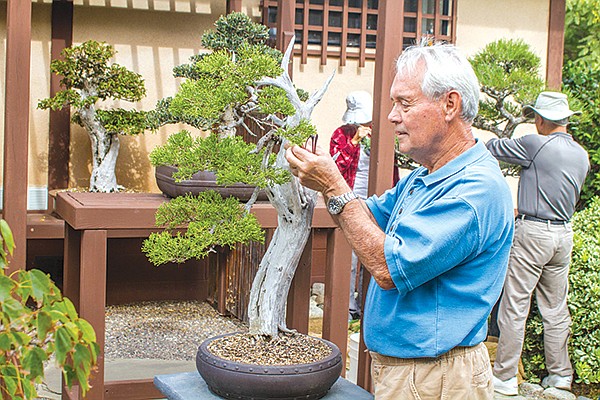
California juniper, Japanese Friendship Garden
Across Pan American Road, look for the entrance of the Japanese Friendship Garden to your right, just past the Tea Pavilion eatery. Pay your fee ($10 adult, $8 student/senior) — or go for free on the third Tuesday of the month, if you’re a resident — and wander the grounds contemplating your relationship with nature. Follow the path past the exhibit hall and the offices, keeping the back gate to your right. As the path curves to the left, you’ll come upon the garden’s bonsai collection, which is curated and maintained by the San Diego Bonsai Club.
Over the phone, Nancy Wilson-Ramon, a volunteer at the Bonsai Club, explains that the two organizations have developed the collection “in concert” and emphasizes their strong relationship, “which, given my exposure to city government, doesn’t happen often,” she says, laughing.
On a cool Wednesday morning in late September, Glen Jensen, the Bonsai Club’s curator for the Japanese Friendship Garden, introduces me to a 200-year-old California juniper (Juniperus californica) planted in a round, shallow pot. It looks like piece of weathered driftwood with branches sporting bright green scale-like leaf foliage only on the left-hand side from where we stand. Jensen, who has been cultivating bonsai for 40 years (give or take), explains that bonsai are typically designed to create a triangular shape and points out the isosceles triangle of this particular tree. “It’s got movement and drama,” he says. “We always go for that uneven, imperfect outline, which is also kind of a Zen Buddhist thing — there’s nothing perfect in this world.”
This California juniper was collected from in the high desert by Sherwin Amimoto in the 1980s and stands 31 inches tall. It has been designed in the “Bunjin” or “Literati” style of bonsai that defies a few of the 50 or so standard artistic principles of bonsai. One bonsai website describes trees done in the Literati style of bonsai as “irregular,” “disfigured,” “skimpy and lonely,” and “a form of agony.”
“[Bonsai] is a living art,” Jensen says. “I love art. Things that visually turn you on. But then you also have to keep it alive. You can’t just do a painting and hang it on the wall. These are constantly changing. They’re never finished.”
Jensen doesn’t want to come up with a name for this bonsai off the top of his head. “I want to be careful, because it’s an important thing in Japan to name a tree.”
A week later, he calls to tell me that he does not have a name for the tree. Then he puts me on the phone with Wilson-Ramon, who explains that to name it would require not only consensus from a number of people in San Diego and beyond, but also meetings and ceremonies and all sorts of other formalities that may or may not ever happen. So, this 31-inch California juniper will remain unnamed.
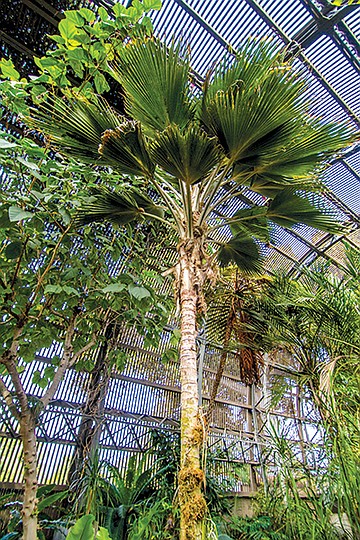
lelo palm, Botanical Building
After Friendship Garden, head over to the lush and dense vegetation at the Botanical Building. Take your time on the way over. Maybe have your picture drawn by one of the caricature artists, dance to the musical offerings of a didgeridoo player, or stop to provide assistance to a group of Chinese tourists whose selfie sticks are not long enough to get the whole group in a photo in front of the Botanical Building.
Once you have made your way into the dappled light and moist air of the botanical building, look for the carnivorous plants. Our next tree is not carnivorous, but it’s nearby. Directly across from the aisle from the raised bed where the meat-eating plants live stands the Loulu lelo palm (Prichardia hilebrandii). If you don’t see it right way, look up and find its pleated fronds against the building’s curved lath ceiling. Although these palm trees are commonly available and grown in California, they are nearly extinct in their wild native range.
“These used to grow pretty much throughout the Hawaiian island chains, but currently they’re somewhat relegated to one rocky pile off the island of Moloka’i,” Kim explains. “There’s about 3000 of them on about a three-acre plot on the top of this rocky cliff side, so there’s constant fear that a storm or a disease will come through and that they’ll just be extinct in the wild.”
Loulu lelo palms reach up to approximately 25 feet. Kim estimates this one at around 30 feet and says it was planted in the Botanical Building in 1997.
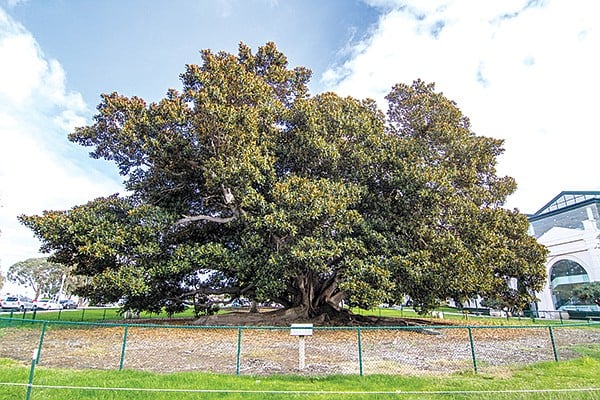
Moreton Bay fig behind the Natural History Museum
From the Botanical Building, head east through the courtyard and under the arcade. You’ll emerge into Village Place, just south of the Casa Del Prado Theater. Ahead of you, in the grassy area behind the Natural History Museum, stands the Beyoncé of Balboa Park’s trees — as in, so famous it needs extra security. The second Ficus macrophylla on our list has a green chain-link fence set at a 50-yard perimeter from its base as well as a single white rope set at about a ten-yard perimeter from the green fence.
The fence that surrounds the tree is not to keep people from climbing it, but to minimize compaction of the soil around it. In the mid to late ’80s, the tree went into serious decline, and arborists determined that the compacted soil was the issue. It was not allowing the proper aeration and water to get down to the delicate root system beneath. In November 1987, the park put up a fence, and the tree recovered. Ten years later, the fence was moved another ten feet out. An elevated viewing platform that allows visitors to get up close to the tree to view it from beneath its canopy without risk of soil compaction is currently in the design phase. (To get an idea of what the tree might look like today without the erection of the fence, look for the dead Moreton Bay Fig in Golden Hill Park.)
This famous ficus was planted in 1914, just before the 1915 exposition, and in 1996, it was measured at a height of 78 feet and a canopy spread of 123 feet. (A current inventory is underway to get updated measurements of it and the 16,000 other trees in the park.) The fencing is clearly doing its job. Not only does no one attempt to approach it while I sit for a half hour on a warm Tuesday afternoon, but hardly anyone looks in its direction.
Finally, a family of three Polish-speaking park visitors does stop and shoot a photo with the tree as a background. When I ask if they’d like to give the tree a name, they smile self-consciously and begin to walk away. Just as I’m wondering if the language barrier has disrupted our communication, the young woman flashes her wrist tattoo at me. “Leo,” it reads. “How about Leo?” she says with a big smile.
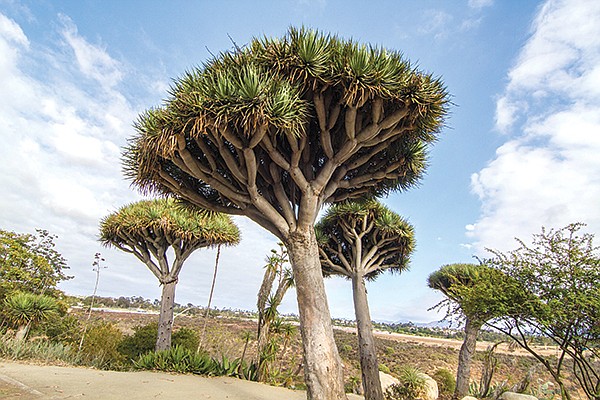
Dragon tree, Park Boulevard desert garden
Use the pedestrian bridge east of the Natural History Museum to cross Park Boulevard. Once a across, a few yards north, you’ll see four dragon trees (Dracaena draco) stand at the entrance to the Desert Garden. John Blocker, horticultural historian and writer for California Garden Magazine, chose the largest of them over any of the garden’s lively giant cacti for placement on this list.
“These trees say ‘Balboa Park,’” Blocker says on the morning he accompanies me to view the trees up close. “They signify a period of horticultural history in San Diego. They’re part of the park heritage.”
Looking up the long, smooth gray trunk where it splits off into an umbrella-like cluster of chubby-looking branches that fork upward, I’m reminded of sausage links. Dracaena draco hails from the Canary Islands, where the Guanche people used its sap in their mummification process. It is a member of the asparagus family.
Blocker explains that although there are several dragon trees around San Diego, they’re not commonly chosen for planting these days. They were more popular back in early 20th Century, so they’re more often found near older homes. Here in the park, several were planted in preparation for the 1915 exposition. You can find them near the Natural History Museum and along the Prado. As far as Blocker knows, none in the park are as big as this one, which he estimates at 25 feet tall with a trunk diameter of 3.5 feet.
Blocker chooses the name Frank Allen, Jr. for this dragon tree, after the man in charge of designing and installing the landscape for the 1915 exposition.
Mexican Elderberry, Florida Canyon
Down the hill eastward in Florida Canyon, one of the few remaining natural areas of the park, Grandpa keeps pretty much to himself. Not only does Kim suggest that this Mexican elderberry (Sambucus mexicana) may be one of the oldest trees in the park, but it’s also the only naturally occurring tree on our list — everything else was planted by gardeners, landscapers, and park designers. As far as Kim knows, Grandpa grew here before the park was a park.
To find Grandpa, head down into Florida Canyon by way of Zoo Drive. Then, a few yards north, head into the bush via the path on the west side of Florida Street. Follow the trail a hundred yards or so over a dry creek bed until you come to an “opening” in the bushes on the left. There, you’ll find Grandpa tucked in among the dry grasses. He’s really more of a shrub than a tree.
“This was one of the most-used plants by Native Americans, but especially the Kumeyaay because you can hollow out the pith to make flutes and things like that,” Kim says. “They used the berries to make elderberry wine. It was an incredibly useful tree to Native Americans.”
One online description says of the Mexican elderberry’s fruits, “Its bluish-black berries are excellent in jelly, fair in pie.”
Grandpa has an approximately two-foot diameter and Kim estimates that he “could be several hundred years old.”
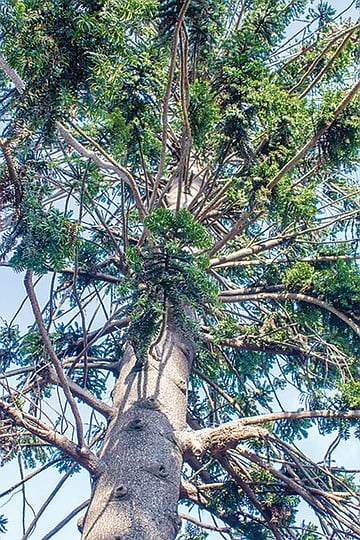
Bunya bunya trees, Golden Hill Park
To get to the tenth tree, you’ll need to cross Florida Canyon and head up the hill to Golden Hill Park, which even though it has its own name is still part of Balboa Park. On the eastern side of the park, Kim introduces me to a grove of old bunya bunya trees. Arucaria bidwillii is an evergreen conifer native to northern Australia. The branches arrange around the trunk in clustered whorls, giving it a kooky, pimpled look, and the spiky leaves burst from tufts that grow only at the end, so the rest of the branch remains bare. These trees look like Dr. Seuss drawings.
But their cones are no joke. The bunya-bunya tree produces one of the largest seed-cones in the world — they can grow twice the size of a man’s head and weigh up to ten pounds. “We have to come out and harvest [the cones],” Kim says. “You don’t want a ten-pound cone falling on someone.”
The cones contain nuts that can be eaten raw, roasted, sliced, pureed, or milled into flour and used in dough. Think bunya nut pesto and bunya nut pudding. They only produce once the tree is 100 years old, and even then only every two to three years. The aboriginal people of Queensland considered the tree to be sacred. Today, the annual Bunya Dreaming festival takes place in the Sunshine Coast Hinterland in Australia (whenever there’s a decent crop of bunya nuts) to celebrate the bunya bunya tree.
Kim estimates that this grove of bunya bunyas was planted sometime in the 1880s by groups of private citizens who lived in the area. Bunya bunya trees can live up to 600 years.


At 8 a.m. on a cool Wednesday morning in fall, park gardeners keep to the edges of the main thruways so the early-morning joggers can maintain their speed through the park’s heart from Sixth Avenue to Park Boulevard. But while gardeners garden and joggers jog, a smattering of tourists wander in and out of the covered walkways around the Plaza de Panama gripping the straps of their backpacks while they wait for the museums to open. They must not know that Balboa Park’s museums open at 10 on weekdays.
For the sake of these waiting wanderers, and for the residents and return visitors looking for another park experience, I enlisted the help of some knowledgeable local folks to create a list of the top ten trees in Balboa Park, which are accessible at any hour. (Although, be advised that there’s a reason city park rangers wear bulletproof vests and carry guns.)

One thing to know before reading on is that of the 400-plus species growing in the park, there are far more than ten spectacular, interesting, important, or historical trees, including 25 or 30 types that historically have been known to live 1000 years.

“At a certain point, when the buildings have crumbled and all the people are gone, some of these plants could be only halfway through their lives,” says Kim Duclo, a longtime city park ranger.

Besides old trees, the park is home to some rare trees, some bizarre trees, and some beautifully ordinary trees, so the number of possible top-ten lists is infinite.
Canary Island pines, Marston House
Our tour begins as you enter the grounds of the Marston House Museum at Seventh and Upas, near Balboa Park’s far northwest corner. Immediately after you cross into the grounds, take ten steps and crank your neck back to look all the way up to the tops of the eight Canary Island pines (Pinus canariensis) that grow on either side of the walkway.

If the wind is blowing and the sun is shining, the dark green pine needles at the top will catch the light and sparkle. These evergreen trees are native to the Canary Islands of Spain and have a fissured red-brown bark that looks almost like puzzle pieces. They are huge and awe-inspiring. According to Kim, these eight evergreens were planted somewhere around March/April of 1906, and the tallest of them is approaching 120 feet. On a sunny Tuesday afternoon in September, I catch a man named Ted Bruno walking past this small grove with a piece of pizza in each hand, and I ask him to pick a favorite of the eight to be included in the list. He looks up, looks around, and chews his pizza, contemplating the question. Finally he says, “If they’re part of the same group, I think we should favor them all.” And so we shall. This group, then, is the first tree on our list.

Gandalf Australian tea tree. Marston House
From the Canary Island pines, stay on the paved walkway, take a few steps toward the house, and look for the low-growing, gnarly tree on the left. This Australian tea tree warrants a history lesson from Kim, who tells stories of scurvy (caused by vitamin C deficiency) for the Europeans on Captain Cook’s voyages of discovery in the South Pacific. Somewhere along the way, they learned that if you boiled the leaves of the Australian tea tree, you could make a tea with a high vitamin C content to ward off the disease. Considered a shrub or multi-trunk tree, the Leptospermum laevigatum has what’s called a prostrate growth habit whereby the twisty trunks grow nearly horizontal along the ground and occasionally set down roots where the limb sits. The low, wide canopy of this particular tree (which Kim says was likely planted by Balboa Park’s godmother Kate Sessions around 1906) provides a nook to escape the world for a while.
“What I love about this is its crazy, twisty, gnarled look,” Kim says on a cloudy afternoon in late August. “I don’t know whether it looks like it’s from Harry Potter or Lord of the Rings.”
A month later, I meet a man named Robert Gill who happens to be wandering the Marston House grounds drinking a bottle of water and “looking for inspiration.” When I ask him to give the tree a name based on either Harry or Lord, he chooses “Gandalf.”

Moreton Bay fig, Palm Canyon
From the Marston House grounds, head south on the paved path that runs parallel to Balboa Drive (itself parallel to Sixth Avenue) and make your way toward El Prado (Laurel Street). Along the way, you’ll spot a couple of homeless encampments, a construction worker or two resting in the shade on a lunch break, and maybe a speed-walker. After you pass Redwood Circle (where many of the eponymous trees are dying), the Trees for Health Garden, and the Lawn Bowling lawn, turn left onto Cabrillo Bridge. Cross the bridge, pass the Museum of Man, and when you get to Alcazar Garden turn right and head for the parking lot on the other side of the maze of low hedges. Feel free to stop and chat with one of the plein air painters that often work in this spot.
Cross the parking lot and head for the wooden bridge that crosses Palm Canyon. You’ll be walking toward the Organ Pavilion whose whiteness you can glimpse through the foliage ahead. Once you’re on the wooden platform, you’ll see three giant tree trunks directly on your right. Continue walking toward the steps that lead down into Palm Canyon and when you reach them, turn around to look at the Moreton Bay fig tree (Ficus macrophylla) whose massive root structure extends down into the canyon. I have named her Abbey because her height and elegance, and her flying buttress roots, call to mind Westminster Abbey, Notre Dame, and other famous Gothic cathedrals.
I find Eric Ortiz and Michele Stone on the part of the platform that overlooks Abbey’s enormous buttress roots that reach down into the canyon where they take firm hold of the earth. Ortiz and Stone are visiting San Diego from Phoenix for two days. They spent yesterday at a beach in La Jolla and have made it a point to visit the trees of Balboa Park before they head back to Arizona tomorrow. Ortiz has seen Abbey before. Stone has not. When I ask her what she thinks, she makes an explosion sound with her lips as if to say, “Mind blown.” She says, “I don’t know if you can quote that, but…” then makes the sound again.
“We’re going to Facebook like crazy,” Ortiz says, snapping another photo.
Instagrammers, Facebookers, and wedding photographers often climb down into the canyon and up into Abbey’s roots, using them as a dramatic background for photos. The off-the-beaten-path location of this particular tree (which was planted in the 1930s or ’40s) has so far made extra security measures unnecessary. (See tree #7).

Kauri pine, Mingei Museum
Continue across the bridge over Palm Canyon and take a sharp left at the end. Cross the two narrow parking-lot inlet/outlets and then head up the short grassy slope just before you get to the covered walkway outside the Mingei. Look for the tall tree with the mottled peachy-gray trunk covered in peeling bark. Take a moment to get your bearings and soak it in because this tree, the (Agathis australis) may be the most valuable thing in the park. Commonly known as the kauri pine (or just kauri), this slow-growing tree is native to New Zealand and was likely planted here in the late 1930s or early 1940s. The peeling bark prohibits parasitic plants from taking hold.
Kauri trees are among the largest (total mass) in the world and can live upwards of 2500 years. The largest known living kauri tree grows in Waipoua, New Zealand. It’s 150 feet tall and has a trunk girth of 50 feet. Kim estimates the Agathis australis in Balboa Park at about 65 feet tall.
Jacqueline Higgins, director of planning, design, and programs at the Balboa Park Conservancy, was the first to introduce me to this tree. The reverence she has for it makes me feel ashamed of the hundreds of times I’ve walked past it without a single glance.
“When we look at trees, we look at them for their aesthetic beauty but we also look at them for the carbon sequestration,” Higgins says. “A tree this size and this age has a tremendous value for carbon sequestration.”
To prove her point, she directs my attention into the covered walkway next to the tree, pointing out the two stairs up and two stairs down that were built so that the sidewalk would go over the roots and protect the tree.
Kim emphasizes Agnes’s importance, too: “[Horticulturist Kathy Puplava] used to tell me that if we were to get rid of every single plant in this park from worst to best, the last thing that would be left would be this tree. And she even went so far as to say, ‘I don’t just mean plants; I mean paintings and works of art, cars.’ To her, that was the most valuable thing in the park.”
In honor of the tree’s Latin name, Higgins decides that Agnes is a good name for this beauty.

California juniper, Japanese Friendship Garden
Across Pan American Road, look for the entrance of the Japanese Friendship Garden to your right, just past the Tea Pavilion eatery. Pay your fee ($10 adult, $8 student/senior) — or go for free on the third Tuesday of the month, if you’re a resident — and wander the grounds contemplating your relationship with nature. Follow the path past the exhibit hall and the offices, keeping the back gate to your right. As the path curves to the left, you’ll come upon the garden’s bonsai collection, which is curated and maintained by the San Diego Bonsai Club.
Over the phone, Nancy Wilson-Ramon, a volunteer at the Bonsai Club, explains that the two organizations have developed the collection “in concert” and emphasizes their strong relationship, “which, given my exposure to city government, doesn’t happen often,” she says, laughing.
On a cool Wednesday morning in late September, Glen Jensen, the Bonsai Club’s curator for the Japanese Friendship Garden, introduces me to a 200-year-old California juniper (Juniperus californica) planted in a round, shallow pot. It looks like piece of weathered driftwood with branches sporting bright green scale-like leaf foliage only on the left-hand side from where we stand. Jensen, who has been cultivating bonsai for 40 years (give or take), explains that bonsai are typically designed to create a triangular shape and points out the isosceles triangle of this particular tree. “It’s got movement and drama,” he says. “We always go for that uneven, imperfect outline, which is also kind of a Zen Buddhist thing — there’s nothing perfect in this world.”
This California juniper was collected from in the high desert by Sherwin Amimoto in the 1980s and stands 31 inches tall. It has been designed in the “Bunjin” or “Literati” style of bonsai that defies a few of the 50 or so standard artistic principles of bonsai. One bonsai website describes trees done in the Literati style of bonsai as “irregular,” “disfigured,” “skimpy and lonely,” and “a form of agony.”
“[Bonsai] is a living art,” Jensen says. “I love art. Things that visually turn you on. But then you also have to keep it alive. You can’t just do a painting and hang it on the wall. These are constantly changing. They’re never finished.”
Jensen doesn’t want to come up with a name for this bonsai off the top of his head. “I want to be careful, because it’s an important thing in Japan to name a tree.”
A week later, he calls to tell me that he does not have a name for the tree. Then he puts me on the phone with Wilson-Ramon, who explains that to name it would require not only consensus from a number of people in San Diego and beyond, but also meetings and ceremonies and all sorts of other formalities that may or may not ever happen. So, this 31-inch California juniper will remain unnamed.

lelo palm, Botanical Building
After Friendship Garden, head over to the lush and dense vegetation at the Botanical Building. Take your time on the way over. Maybe have your picture drawn by one of the caricature artists, dance to the musical offerings of a didgeridoo player, or stop to provide assistance to a group of Chinese tourists whose selfie sticks are not long enough to get the whole group in a photo in front of the Botanical Building.
Once you have made your way into the dappled light and moist air of the botanical building, look for the carnivorous plants. Our next tree is not carnivorous, but it’s nearby. Directly across from the aisle from the raised bed where the meat-eating plants live stands the Loulu lelo palm (Prichardia hilebrandii). If you don’t see it right way, look up and find its pleated fronds against the building’s curved lath ceiling. Although these palm trees are commonly available and grown in California, they are nearly extinct in their wild native range.
“These used to grow pretty much throughout the Hawaiian island chains, but currently they’re somewhat relegated to one rocky pile off the island of Moloka’i,” Kim explains. “There’s about 3000 of them on about a three-acre plot on the top of this rocky cliff side, so there’s constant fear that a storm or a disease will come through and that they’ll just be extinct in the wild.”
Loulu lelo palms reach up to approximately 25 feet. Kim estimates this one at around 30 feet and says it was planted in the Botanical Building in 1997.

Moreton Bay fig behind the Natural History Museum
From the Botanical Building, head east through the courtyard and under the arcade. You’ll emerge into Village Place, just south of the Casa Del Prado Theater. Ahead of you, in the grassy area behind the Natural History Museum, stands the Beyoncé of Balboa Park’s trees — as in, so famous it needs extra security. The second Ficus macrophylla on our list has a green chain-link fence set at a 50-yard perimeter from its base as well as a single white rope set at about a ten-yard perimeter from the green fence.
The fence that surrounds the tree is not to keep people from climbing it, but to minimize compaction of the soil around it. In the mid to late ’80s, the tree went into serious decline, and arborists determined that the compacted soil was the issue. It was not allowing the proper aeration and water to get down to the delicate root system beneath. In November 1987, the park put up a fence, and the tree recovered. Ten years later, the fence was moved another ten feet out. An elevated viewing platform that allows visitors to get up close to the tree to view it from beneath its canopy without risk of soil compaction is currently in the design phase. (To get an idea of what the tree might look like today without the erection of the fence, look for the dead Moreton Bay Fig in Golden Hill Park.)
This famous ficus was planted in 1914, just before the 1915 exposition, and in 1996, it was measured at a height of 78 feet and a canopy spread of 123 feet. (A current inventory is underway to get updated measurements of it and the 16,000 other trees in the park.) The fencing is clearly doing its job. Not only does no one attempt to approach it while I sit for a half hour on a warm Tuesday afternoon, but hardly anyone looks in its direction.
Finally, a family of three Polish-speaking park visitors does stop and shoot a photo with the tree as a background. When I ask if they’d like to give the tree a name, they smile self-consciously and begin to walk away. Just as I’m wondering if the language barrier has disrupted our communication, the young woman flashes her wrist tattoo at me. “Leo,” it reads. “How about Leo?” she says with a big smile.

Dragon tree, Park Boulevard desert garden
Use the pedestrian bridge east of the Natural History Museum to cross Park Boulevard. Once a across, a few yards north, you’ll see four dragon trees (Dracaena draco) stand at the entrance to the Desert Garden. John Blocker, horticultural historian and writer for California Garden Magazine, chose the largest of them over any of the garden’s lively giant cacti for placement on this list.
“These trees say ‘Balboa Park,’” Blocker says on the morning he accompanies me to view the trees up close. “They signify a period of horticultural history in San Diego. They’re part of the park heritage.”
Looking up the long, smooth gray trunk where it splits off into an umbrella-like cluster of chubby-looking branches that fork upward, I’m reminded of sausage links. Dracaena draco hails from the Canary Islands, where the Guanche people used its sap in their mummification process. It is a member of the asparagus family.
Blocker explains that although there are several dragon trees around San Diego, they’re not commonly chosen for planting these days. They were more popular back in early 20th Century, so they’re more often found near older homes. Here in the park, several were planted in preparation for the 1915 exposition. You can find them near the Natural History Museum and along the Prado. As far as Blocker knows, none in the park are as big as this one, which he estimates at 25 feet tall with a trunk diameter of 3.5 feet.
Blocker chooses the name Frank Allen, Jr. for this dragon tree, after the man in charge of designing and installing the landscape for the 1915 exposition.
Mexican Elderberry, Florida Canyon
Down the hill eastward in Florida Canyon, one of the few remaining natural areas of the park, Grandpa keeps pretty much to himself. Not only does Kim suggest that this Mexican elderberry (Sambucus mexicana) may be one of the oldest trees in the park, but it’s also the only naturally occurring tree on our list — everything else was planted by gardeners, landscapers, and park designers. As far as Kim knows, Grandpa grew here before the park was a park.
To find Grandpa, head down into Florida Canyon by way of Zoo Drive. Then, a few yards north, head into the bush via the path on the west side of Florida Street. Follow the trail a hundred yards or so over a dry creek bed until you come to an “opening” in the bushes on the left. There, you’ll find Grandpa tucked in among the dry grasses. He’s really more of a shrub than a tree.
“This was one of the most-used plants by Native Americans, but especially the Kumeyaay because you can hollow out the pith to make flutes and things like that,” Kim says. “They used the berries to make elderberry wine. It was an incredibly useful tree to Native Americans.”
One online description says of the Mexican elderberry’s fruits, “Its bluish-black berries are excellent in jelly, fair in pie.”
Grandpa has an approximately two-foot diameter and Kim estimates that he “could be several hundred years old.”

Bunya bunya trees, Golden Hill Park
To get to the tenth tree, you’ll need to cross Florida Canyon and head up the hill to Golden Hill Park, which even though it has its own name is still part of Balboa Park. On the eastern side of the park, Kim introduces me to a grove of old bunya bunya trees. Arucaria bidwillii is an evergreen conifer native to northern Australia. The branches arrange around the trunk in clustered whorls, giving it a kooky, pimpled look, and the spiky leaves burst from tufts that grow only at the end, so the rest of the branch remains bare. These trees look like Dr. Seuss drawings.
But their cones are no joke. The bunya-bunya tree produces one of the largest seed-cones in the world — they can grow twice the size of a man’s head and weigh up to ten pounds. “We have to come out and harvest [the cones],” Kim says. “You don’t want a ten-pound cone falling on someone.”
The cones contain nuts that can be eaten raw, roasted, sliced, pureed, or milled into flour and used in dough. Think bunya nut pesto and bunya nut pudding. They only produce once the tree is 100 years old, and even then only every two to three years. The aboriginal people of Queensland considered the tree to be sacred. Today, the annual Bunya Dreaming festival takes place in the Sunshine Coast Hinterland in Australia (whenever there’s a decent crop of bunya nuts) to celebrate the bunya bunya tree.
Kim estimates that this grove of bunya bunyas was planted sometime in the 1880s by groups of private citizens who lived in the area. Bunya bunya trees can live up to 600 years.
Comments